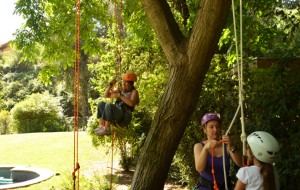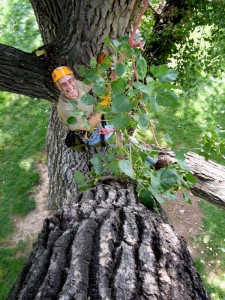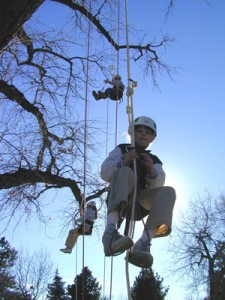Climbing Trees

Originally appears in the Spring 2013 issue
I climb trees. I do it because I love being in forests and among trees: not just among them, but up in them. I love the adventure, the experiencing of something new every climb, the physical challenge, the joy, the opening up of the world. As a Master Instructor, I also take groups climbing and I teach others to climb or to lead groups themselves. I am also the president of the umbrella non-profit helps to standardize climbing guidelines and curricula for training courses, and promote public awareness of the safe practice of recreational tree climbing (RTC), sometimes also known as experiential or technical tree climbing.
I want you to climb and perhaps someday facilitate your own group climbs. Why climb trees? On a very basic level, we all sense that it feels good to be around trees and forests. But beyond engendering a sense of well-being, there is a growing body of scientific evidence that being in the forest environment has positive psychological effects. In studies done at Kyoto University, researchers found that walking or simply being in a forest – something the Japanese call “shinrin-yoku” – had a noticeable effect on stress levels. When they compared levels of hostility and depression on days where subjects took two short walks in a forest, to days without walks, there was a noticeable difference. The researchers concluded that being in a forest was beneficial for maintenance of mood and reduction of stress levels. What’s more, they found particular benefit for those experiencing extreme or chronic stress, suggesting that shinrin-yoku could have therapeutic benefits.[1]
Studies concerning the psychological and physiological effects of tree climbing are also being done. John Gathright and other researchers in Japan have found that study participants who climbed trees were more relaxed, yet more energized, with reduced levels of tension, confusion and fatigue, when compared with those who climbed an inanimate tower and were assessed for the same variables.[2] In another case study, these same researchers found that tree climbing activities can enhance social and communal relationships, as well as optimize local restoration and conservation initiatives.[3]
As someone trained in eco-psychology and systems theory, let me add another perspective. During the Paleocene and Eocene eras, when forests were expanding across what is now North America, there were arboreal primates expanding their range along with them – ancient relatives of lemurs and tarsiers. The tree dwellers benefited by being safe from predators, while the trees received help in dispersing their seeds. Primates could climb to an abundant food supply in the canopy, while the trees were exercised and pruned of dead branches. Trees have historically benefited from primate action, through the pruning of deadwood, the spreading of seed, the clearing of tree “dust” and “dandruff”. The ancient forests grew, but the arboreal primates disappeared with a changing environment. Today, with the exception of birds, squirrels and a few other visitors knocking off bits of bark and other material as they scurry along, many of our trees seem eerily silent and empty, perhaps even lonely? Do we also feel a certain loneliness when we are away from trees and forests, and thus away from what was our ancestral habitat? Perhaps that is why we feel a natural urge to care for and connect in some way with trees.
When you climb up into a tree, you have an almost immediate feeling of peace, of connecting with something deep-seated and right, almost of coming home. I’ve seen some first time climbers become completely still and silent at the top of their climb, not wishing to talk or do anything but immerse themselves in the experience. Upon returning to ground level, some of these climbers will tear up trying to explain what it meant to them, having been so unexpectedly moved by the experience.
Recreational tree climbing (RTC) programs take place at nature centers, arboreta, schools, preserves, parks & recreation districts, and numerous other venues in North America and in countries as diverse as Japan, England, Taiwan, Australia and Chile. Introductory climbs are offered to the public by formally trained facilitators, either partnering with a public or private entity, or at their own site, often called “groves”. (Yes, we’re a bit into tree-themed terminology.)
Here’s how a typical climbing program might work if an organization were to contract with a facilitator. For example, I conduct programs in partnership with South Suburban Parks & Recreation District in Littleton, Colorado. In consultation with their personnel, we picked out a tree suitable for climbing activities in one of their parks. We determined a climbing schedule and they added it to their catalog and online registration system. We agreed to charge climbers between ~US$25-$35, depending on age, and whether participants were in-district or out. We provided all the equipment and necessary instruction.

Climbs last about 2 ½ hours for groups of about a dozen participants, ages 7 and up. I begin with a talk on safety, climbing procedures and other necessary information, followed by some warm-up exercises. I also talk about the particular tree species we’ll be climbing, sharing interesting background information on its natural history, importance to the local ecosystem, and perhaps some folklore and other stories. I usually expand on these elements when conducting climbs for school or other environmentally-interested groups.
Once aloft, climbers can do many things. They can walk along branches (always on-rope), swing from branches or hang upside down. They might rest on branches or in sky chairs or tree boats (hammocks specifically made for tree climbers), make observations as part of a class activity, or simply explore, look, and enjoy.
Recreational tree climbing is done using saddles, helmets and arborist rope which have been doubled over a suitable anchor point in the tree. This gives the climber a 2-to-1 strength advantage compared to climbing a single rope. Connecting hitches and knots are tied in one end of the rope allowing the climber to ascend and descend safely and easily. We protect the bark from the sliding rope by using cambium-saving devices.
Organizations can also choose to have a recognized instructor train their own in-house personnel to become facilitators. Students can train with a local instructor if available. If none are available, one has the option of travelling to an instructor, or having them travel to you.
As a prerequisite, the Facilitators Course includes basic tree climber training which is also taught by a recognized instructor. The two courses can often be taught consecutively over one week, with a waiting period of six months before the first unsupervised facilitated climb, to allow for logged basic climbing experience to build. Apprentice Facilitators always keep in touch with their Instructors, who are available to provide feedback, answer questions, and share the latest developments in the field.
Costs for training vary per instructor. The Basic Tree Climbing Course and the Facilitators Course each cost approximately US$450-$500. Discounts are often available for multiple students from the same organization, or for those doing both courses concurrently.
Tree climbing facilitators require a very different skill set than tree care and arboriculture, although there are many instructors who are trained in both. One reason the Global Organization of Tree Climbers (GOTC) was created was to respond to safety issues that occurred on climbs conducted by those not specifically trained to facilitate such climbs. (From time to time, untrained individuals have decided they were qualified to go out and start a tree climbing business.) It is worth noting that over the past 30 years, approximately 500,000 individuals have climbed trees without a significant injury under the auspices of courses recognized by the GOTC.
Does this all sound like something you’d like to try, either as an individual climber or as a program for your organization or school? If so, I’ll look forward to meeting up with you in the canopy some day.
Global Organization of Tree Climbers (GOTC)
On the GOTC website at www.gotreeclimbing.org, you will find under “Go Climbing”, a worldwide map, showing the names and contact information of many facilitators and instructors. Also found on the site are videos and other information. Contact Harv with any questions you might have.
[1] Morita E, Fukuda S, Nagano J, Hamajima N, Yamamoto H, Iwai Y, Nakashima T, Ohira H, Shirakawa T. “Psychological effects of forest environments on healthy adults: Shinrin-yoku (forest-air bathing, walking) as a possible method of stress reduction,” Public Health. 2007 Jan;121(1):54-63. Epub 2006 Oct 20.
[2] Gathright, John; Yamada, Yozo; Morita, Miyako. “Comparison of the physiological and psychological benefits of tree and tower climbing,” Urban Forestry & Urban Greening vol. 5 issue 3 October 2, 2006. p. 141-149.
[3] Gathright, John; Yamada, Yozo; Morita, Miyako “Recreational tree-climbing programs in a rural Japanese community forest: Social impacts and ‘fun factors’,” Urban Forestry & Urban Greening vol. 6 issue 3 October 1, 2007. p. 169-179.
To view the photo-rich magazine version, click here.
If you are not already a subscriber, please subscribe to read the full article
Harv Teitelbaum operates Tree Climbing Colorado and lives in Evergreen, Colorado. He is the current President of the Global Organization of Tree Climbers (see below) and can be contacted at info(at)gotreeclimbing.org.
Leave a Reply
You must be logged in to post a comment.







If you are in the Northeast Cornell Tree climbing offers similar curriculum.
https://treeclimbing.coe.cornell.edu/